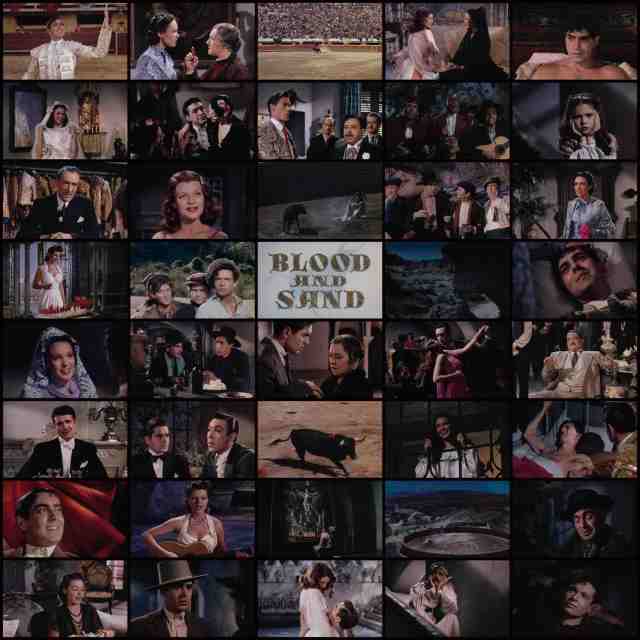
Title: Blood and Sand
Year: 1941
Country: USA
Language: English
Genre: Drama, Sport
Director: Rouben Mamoulian
Screenwriter: Jo Swerling
based on the novel by Vicente Blasco Ibáñez
Music: Alfred Newman
Cinematography: Ernest Palmer, Ray Rennahan
Editor: Robert Bischoff
Cast:
Tyrone Power
Linda Darnell
Rita Hayworth
Alla Nazimova
Anthony Quinn
John Carradine
Laird Cregar
Rex Downing
Lynn Bari
Monty Banks
J. Carrol Naish
Ann E. Todd
Pedro de Cordoba
George Reeves
Fortunio Bonanova
Rating: 7.4/10

Spanish novelist Vicente Blasco Ibáñez (1867-1928)’s BLOOD AND SAND has already been adapted to the silver screen twice (including a Rudolph Valentino picture in 1922) prior to this polychromatic version retrofit and varnished with a sumptuous veneer by Rouben Mamoulian, BLOOD AND SAND stars Tyron Power as the Seville bullfighter Juan Gallardo, with two mesmerizing screen beauties Linda Darnell and Rita Hayworth counterpoising each other as Juan’s saintly wife Carmen Espinosa and the minxy socialite Dona Sol des Muire respectively (a proviso to appreciate any Tinseltown production is that Hollywood never takes ethnic authenticity seriously, at least not in that antediluvian insensitive era).
Less to be expected in the story’s from-cradle-to-grave, rags-to-riches tropes of a young bullfighter’s meteoric rise and fall, Mamoulian decisively downplays the bullfighting spectacle, Power’s first on-screen matador performance clocks in nearly an hour into the film, and Mamoulian prefers showing audience’s rapturous reaction shots than the actual baiting in the arena, which is done by professional ones with Power stands in for close-ups. The occasion behind this unconventional approach stems from a judicious anti-bullfighting message, which Mamoulian and screenwriter Jo Swerling make great play through the long-suffering women in the persons of both Carmen and Juan’s mother Señora Angustias (Nazimova), who are inevitably put through the wringer of blindly praying for Juan’s safety every time he steps out to entertain the audience, the latter even has to experience the same torment twice a lifetime, Juan’s father is also a matador and died from being gored by a bull, Russian actress Alla Nazimova (who is also famous for her bisexual proclivity off the screen, presumably involved with both Rudolph Valentino’s two wives!) is phenomenal in uttering the most stirring line out of sheer agony: she doesn’t pray Juan to be safe, but to be gored, not to death, only to be injured so that he can retire from this dangerous line of work before it is too late, alas, Ibáñez isn’t kind enough to reserve that merciful exit strategy for him.
Without much to flaunt his usual swashbuckling persona, Power carves out a solid trajectory of Juan’s masculine mindset, he is simple-minded, virile, passionate, but also naive, weak and overcompensates his shameful illiteracy with wealth and fame that he has no means to maintain, another salient point declaimed by one of his child friends among his retinue, the ill-fated El Nacional (a beanpole Carradine) in extremis, who has repeatedly expressed his resolve to quit the sleazy business “it will be my last season!”.
While Darnell’s docile Carmen possesses a blue-sky understanding of her husband’s affairs, a form of true love every man dreams for, it is Hayworth’s temptress Dona Sol who leaves audience rapt and bewitched, in her first Technicolor film, Hayworth looks a bit out-of-sorts with her asymmetric eyes, but slowly, she gets her mojo back when in full glamorous mode, Dona Sol is an unqualified creature made to steal any man’s heart to her heart’s desire, and Hayworth’s effortless bearing never drags her down to be moralized, it is only a man’s luck to be her quarry, just like Anthony Quinn’s Manolo de Palma, whose victory tastes like a sharp tang in the final shot with someone else’s blood on the sands.
To the end of the day, it is the fickle audience who should be blame for Juan Gallardo’s downfall, and that revelation remains still relevant everywhere, not least in the cutting-throat showbiz, which accords Mamoulian’s fantastically gorgeous-looking picture a timeless inner strength to pass on for generations to come.
referential entries: Mamoulian’s DR. JEKYLL AND MR. HYDE (1931, 8.0/10); Henry King’s THE BLACK SWAN (1942, 6.5/10).

One reply to “[Film Review] Blood and Sand (1941)”